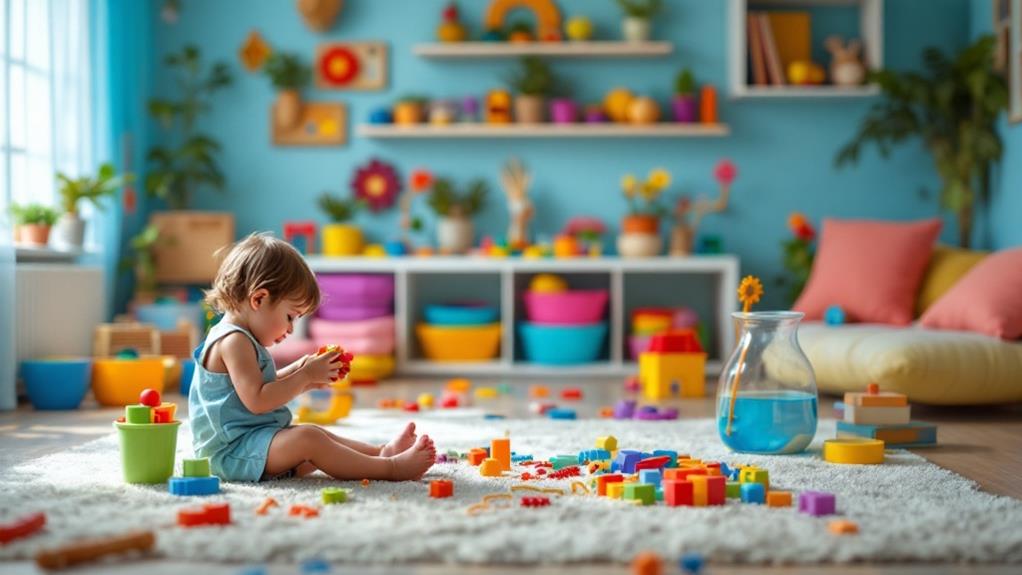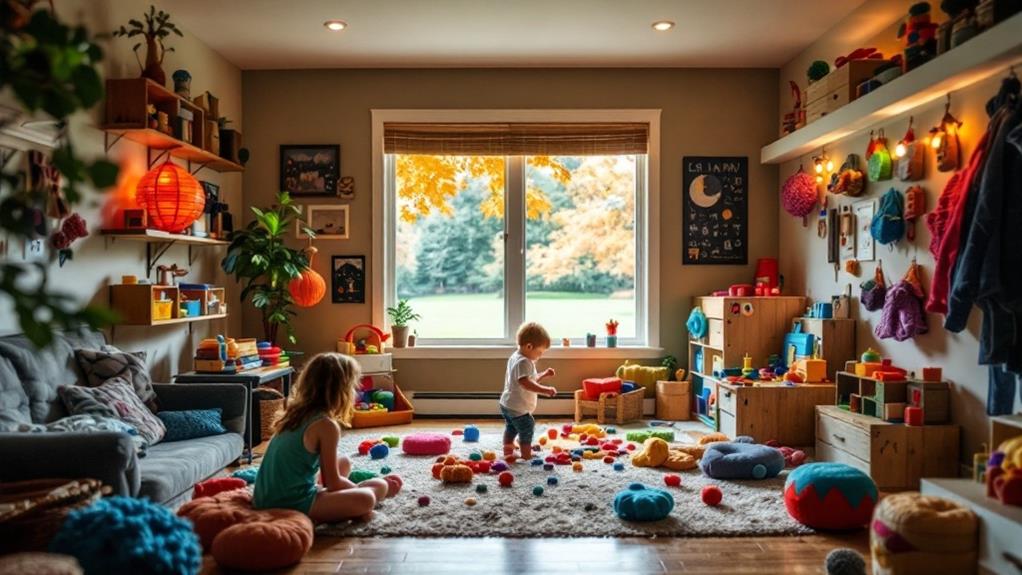Sensory integration is how your child's brain processes sensory information to navigate the world. Sometimes, children face sensory processing challenges, leading to overwhelming reactions to loud sounds or certain textures. These aren't just behavioral issues—they're real responses to sensory overload. With the right support, including occupational therapy, your child can learn strategies to cope and build essential skills for everyday life. Therapists provide techniques tailored to your child's needs, helping them feel more confident and secure. There's a wealth of knowledge available that can empower you as you support your child through their sensory journey.
Key Takeaways
- Sensory integration is the brain's process for organizing and interpreting sensory information to enhance interaction with the environment.
- Children with sensory processing challenges may exhibit overwhelm, seeking behaviors, or difficulties with routines due to sensory overload.
- Occupational therapy provides personalized strategies to help children develop skills for self-regulation and coordination, addressing sensory processing issues.
- Therapeutic techniques include sensory play, weighted products, and mindfulness, promoting effective coping strategies for sensory challenges.
- Creating a sensory-friendly home and collaborating with schools can significantly improve a child's ability to navigate their environment.
Understanding Sensory Integration

Sensory integration is an essential process that helps your child make sense of the world around them. It involves the brain's ability to take in, process, and respond to sensory information from the environment. This includes everything from the feel of a soft blanket to the sound of a busy street.
When your child experiences effective sensory integration, they can better navigate their surroundings, engage with others, and develop crucial skills.
As a parent, you play a crucial role in supporting this process. By creating an environment rich in sensory experiences, you encourage your child to explore different textures, sounds, and sights. Simple activities like playing with playdough, listening to music, or going for nature walks can promote sensory awareness.
When you notice your child engaging with their senses, celebrate those moments! It's important to remain patient, as sensory integration is a gradual journey.
Remember, every child is unique, and their sensory preferences may differ from others. By nurturing your child's sensory development, you're not just enhancing their understanding of the world; you're also fostering confidence and resilience.
Your support makes a significant difference in their growth and happiness.
Sensory Processing Challenges
Maneuvering the world can sometimes feel overwhelming for children facing sensory processing challenges. You might notice that certain sounds, sights, or textures cause your child to react more intensely than their peers. These challenges stem from how their brains interpret sensory information, leading to feelings of discomfort or anxiety in everyday situations.
Imagine a bustling classroom filled with noise and movement. For a child with sensory processing difficulties, this environment can feel chaotic, making it hard for them to focus or engage. They may struggle with shifts, resist certain activities, or seek out sensory experiences in unexpected ways.
As a caring parent or guardian, it's crucial to understand that these reactions aren't about misbehavior; they're genuine responses to an overwhelming world.
The good news is that with the right support, your child can learn to navigate these challenges. Occupational therapy offers targeted strategies, helping children process sensory input more effectively. Through tailored interventions, your child can gain coping skills, increase their comfort level in various environments, and ultimately thrive.
Signs of Sensory Processing Issues

Understanding your child's unique responses to their environment can be both enlightening and challenging. You might notice that your child reacts differently to sights, sounds, textures, or even tastes compared to their peers.
For instance, they may become overwhelmed by loud noises or bright lights, causing them to cover their ears or retreat to a quieter space. Alternatively, they might actively seek out sensory experiences, like spinning or jumping, in ways that seem excessive.
You may also observe that your child has difficulty with routine activities, such as getting dressed or eating, due to sensitivities to certain fabrics or food textures.
Some children may struggle with personal space, either standing too close to others or avoiding physical contact altogether.
These signs can vary widely among children, but recognizing these behaviors is essential in understanding their sensory processing issues.
Impact on Daily Life
The effects of sensory processing issues can ripple through various aspects of daily life, making routine activities feel challenging for both you and your child. Simple tasks, like getting dressed or going to the grocery store, can become overwhelming. You might notice your child struggles with certain textures or sounds, leading to meltdowns or avoidance. This can create a cycle of frustration and anxiety, not just for them but for you as well.
Navigating social situations might also prove difficult. Playdates or family gatherings can feel intimidating, as your child may react differently than their peers, leaving you feeling concerned or isolated. Even daily shifts, like moving from one activity to another, can trigger stress.
It's important to recognize that these challenges don't define your child or your family's potential for joy and connection. By understanding the impact of sensory processing issues, you can create a more supportive home environment.
Small adjustments, like establishing routines or providing sensory-friendly spaces, can make a significant difference. Remember, you're not alone in this journey. With patience and understanding, you can help your child feel more comfortable and confident in their daily life.
Role of Occupational Therapy

Occupational therapy can be a powerful ally in addressing sensory processing issues. When you seek the support of an occupational therapist, you're taking a proactive step toward helping your child understand and navigate their sensory world.
These skilled professionals assess your child's unique sensory needs and create personalized strategies to foster engagement and participation in daily activities.
Through play and structured activities, occupational therapy helps your child develop essential skills like self-regulation, coordination, and social interaction.
You'll often see your child gaining confidence as they learn to face sensory challenges head-on. The therapist will guide you in creating a supportive home environment, offering practical tools and techniques that empower both you and your child.
Therapeutic Techniques and Approaches
How can therapeutic techniques and approaches make a difference in your child's sensory journey? These strategies offer tailored support, helping your child become more comfortable and confident in their environment.
Occupational therapists use various techniques to address sensory processing challenges, making daily activities more manageable and enjoyable.
Here are some effective approaches you might encounter:
- Sensory Play: Engaging your child in activities that stimulate their senses, like sand or water play, can enhance their sensory integration skills.
- Weighted Products: Using weighted blankets or vests can provide calming pressure, helping your child feel secure and focused.
- Visual Supports: Visual schedules and social stories can guide your child through routines, reducing anxiety and uncertainty.
- Movement Activities: Incorporating swings, climbing, or jumping can help your child develop body awareness and coordination.
- Mindfulness Techniques: Simple breathing exercises or yoga can aid in self-regulation, teaching your child to manage overwhelming feelings.
These techniques not only support your child's sensory needs but also empower you as a parent to foster their growth and independence.
Together, you can create a more harmonious sensory experience.
Building a Sensory-Friendly Home

Creating a sensory-friendly home can greatly enhance your child's ability to thrive. Start by evaluating your child's sensory needs; observe how they react to different stimuli. You might find that certain sounds, lights, or textures overwhelm them while others provide comfort.
Begin by decluttering spaces. A tidy environment reduces distractions, helping your child focus better. Consider soft lighting options, like lamps with dimmers, to create a calming atmosphere. You can also invest in noise-canceling headphones or sound machines to manage auditory sensitivities.
Designate a cozy, quiet area where your child can retreat when feeling overwhelmed. Fill this space with calming sensory items, like weighted blankets or soft cushions, to provide comfort and stability.
Incorporate various textures throughout your home—think plush rugs, smooth walls, and soft furniture—to give your child a range of tactile experiences.
Supporting Your Child at School
Supporting your child at school can feel overwhelming, but with the right strategies, you can make a significant difference in their experience.
Children with sensory processing challenges often face difficulties in busy classrooms or during changes. You can help them thrive by implementing thoughtful approaches that cater to their unique needs.
Here are some strategies to take into account:
- Communicate with teachers: Share your child's sensory needs and discuss possible accommodations.
- Create a sensory toolkit: Equip your child with items like fidget toys or noise-canceling headphones to help them manage sensory overload.
- Establish a routine: Consistent schedules can provide predictability, which can be comforting for your child.
- Encourage breaks: Allow them to take short breaks during the day to regroup and reset.
- Be a supportive advocate: Collaborate with school staff to guarantee your child receives the help they need.
Resources for Iowa Parents

As a parent in Iowa, you have access to a variety of resources designed to support your child's sensory integration needs. Local organizations, such as the Iowa Department of Education and various community health centers, offer informational workshops and support groups tailored for families managing sensory processing challenges. These resources provide not just education, but also a sense of community.
You might also consider connecting with occupational therapists who specialize in sensory integration. Many therapists in Iowa work in schools or private practices, helping children develop coping strategies to maneuver their environments more effectively. They can provide individualized assessments and tailored activity plans that fit your child's unique needs.
Don't forget to explore local libraries and community centers, which often host events focusing on sensory-friendly activities. These settings encourage play and socialization while being mindful of sensory sensitivities.
Conclusion
Steering through sensory integration challenges can feel overwhelming, but remember, "It takes a village." As you support your child, you're not alone; there are resources and professionals ready to help. With occupational therapy and a sensory-friendly approach at home and school, you can create an environment where your child thrives. Embrace the journey, celebrate small victories, and trust that with patience and understanding, your child can learn to steer their world with confidence and joy.
